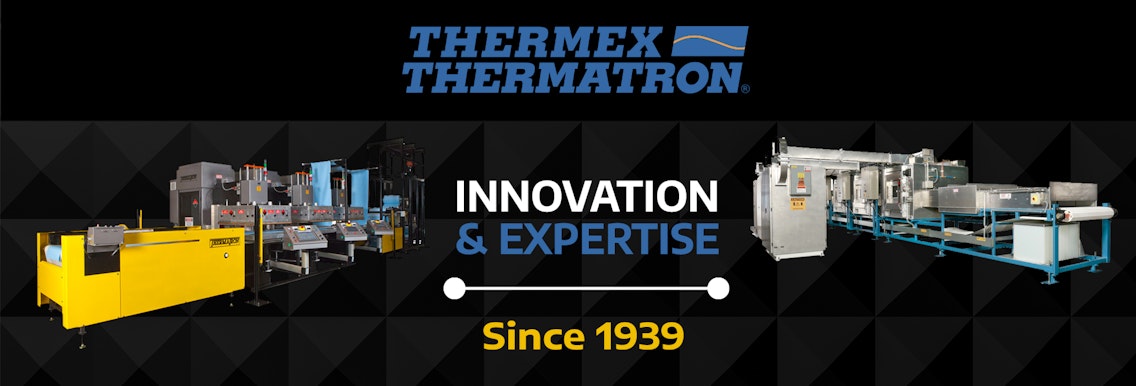RF Breakdown In Dielectric Materials
Thermex-Thermatron Systems
The application of radio frequency (i.e. RF) heating may lead to breakdown in dielectric materials. This can be problematic in a production setting, as it can have detrimental effects on equipment and processes. That is why it is important to be able to understand and identify RF breakdown in dielectric materials, also referred to as “arcing.”
Stages of Arcing
Arcing is a sequence of processes leading to a change from an insulation state to a conducting state. This sequence is often rapidly occurring and can be broken down into four successive stages:
Stage 1 - The Initial State: In the initial state, the dielectric material conductivity increases.
Stage 2 - The Current Runaway Stage: In the current runaway stage, electrical instability is produced.
Stage 3 - The Electrostatic Discharge Stage: Next, voltage collapse with discharge of the electrostatic energy occurs through the breakdown channel.
Stage 4 - High Current Stage: Finally, the material settles down to a low-voltage and high-current state.

Common Variables that Lead to Arcing
Insulating material cannot sustain indefinite voltages. This principle varies depending on the properties of the insulating material. However, the fact remains that breakdown will occur at a certain electrical field at some point. Generally, the voltage at which the arcing occurs is defined as the dielectric strength of the material. To determine dielectric strength, the following parameters must be considered:
● Length of time of voltage application.
● Shape and thickness of insulating material.
● Temperature, frequency, microscopic defects, and macroscopic defects.
● Presence of interface materials, such as contaminants and humidity, etc.

Breakdown in gases are generally produced by impact ionization of the gas molecules. There are two kinds of conductive states after breakdown occurs: the glow discharge (observed at lower voltages) and the arc discharge (occurring at voltages above 300 volts).
In solids, breakdown is caused mainly by thermal, electronic, internal, and external discharge mechanisms. This occurs primarily at high frequencies caused by dielectric loss. This thermal instability has the potential to cause exponential rise of conductivity, which then causes rapid decrease of the breakdown voltage or dielectric strength.
Electronic breakdown is often a result of various processes, such as impact ionization, field emission, insulator-to-metal transition, etc. Arcing of an insulator, in particular, is usually ascribed to the interaction of three factors: impact ionization, charge carrier injection into the insulation, and the effect of space charges.
Breakdown from External and Internal Discharges
Breakdown by internal discharges becomes possible when the voltage is sufficient to cause sparking in the cavities of a solid. Discharges in cavities can cause erosion by sputtering, chemical reactions, local melting, and evaporation. This can promote the breakdown in the adjacent solid. Such destructive processes can happen quickly at high frequencies, and the breakdown progresses through the insulator in branched channels in the form of treeing.
External discharges can occur even at lower voltages than internal discharges. Such discharges occur along the interface of an insulator with a gaseous or liquid medium. The development of electric charges along surfaces is enhanced by the interaction between the solid and the gas or liquid, leading to arc tracing on the surface of the solid. Tracing then produces conducting channels in the form of treeing. The conditions for arc tracing are especially favorable on impure surfaces and in humid atmospheres. These discharges, as well as those that occur in cavities, are often referred to as “corona discharges.”

Calculating the Risk of Arcing
Arcing over dielectric materials is a complex process. Contributing factors include the relative humidity of the air surrounding the electronic components working at high frequencies and the voltages. The effect of humidity can be analyzed in the context of other factors, such as:
● Air temperature
● Surface temperature of a component
● Surface contamination
● Hygroscope of the dielectric material that makes up the insulators or work piece
● Moisture content of the work pieces
● Ionic Content
● Level of homogeneity of the materials
Example: Cold surfaces could facilitate moisture condensation, thus reducing the insulating values of the dielectric material, particularly when contamination is present.
To calculate the probability of arcing at a given relative humidity, proceed as follows:
- Estimate or record the number of arcs in dry air conditions (less than 20% humidity).
Example: N = 4 arcs per 24 hours - Select the value of the relative humidity you want to use to calculate the probability of arcing
Example: H = 80% - Read the corresponding value of the frequency of arcing:
Example: F - 83%
The number of arcs that might occur at 75% relative humidity is 23.53. The equation Nh = (N x 100) / (100F) in this case looks like (4 x 100) / (100 - 83) = 23.53. This number will be significantly higher, up to 70 to 100, when other factors are considered, such as conductor shape, contamination, and temperature.
Detect and Suppress Arcing with Thermex-Thermatron
Arcing is damaging to equipment, materials, and processes. Your production does not need to be slowed down or harmed by this, though. The engineers and machinists at Thermex-Thermatron understand RF arcing and how to mitigate it. We build our systems with risk management in mind and offer parts and services to ensure that the potential side effects of RF heating technology do not get in the way of its vast benefits. Parts available from Thermex-Thermatron for this issue include an RF Detection Scanner and RF Arc Suppressors.
For assistance in pricing and availability on these or any other parts, please contact our Purchasing Department at (502) 482-1299 ext. 208 or purchasing@thermex-thermatron.com
For Thermex and Thermatron inquiries, contact our Director of Sales, Dean Mancuso (Sales@thermex-thermatron.com; 502/916-8972 or 502/243-5636).
For FIAB and Oteman inquiries, contact our Director of Business Development, Traci Evling (Traci@thermex-thermatron.com; 502/916-8981 or 904/662-2169).


